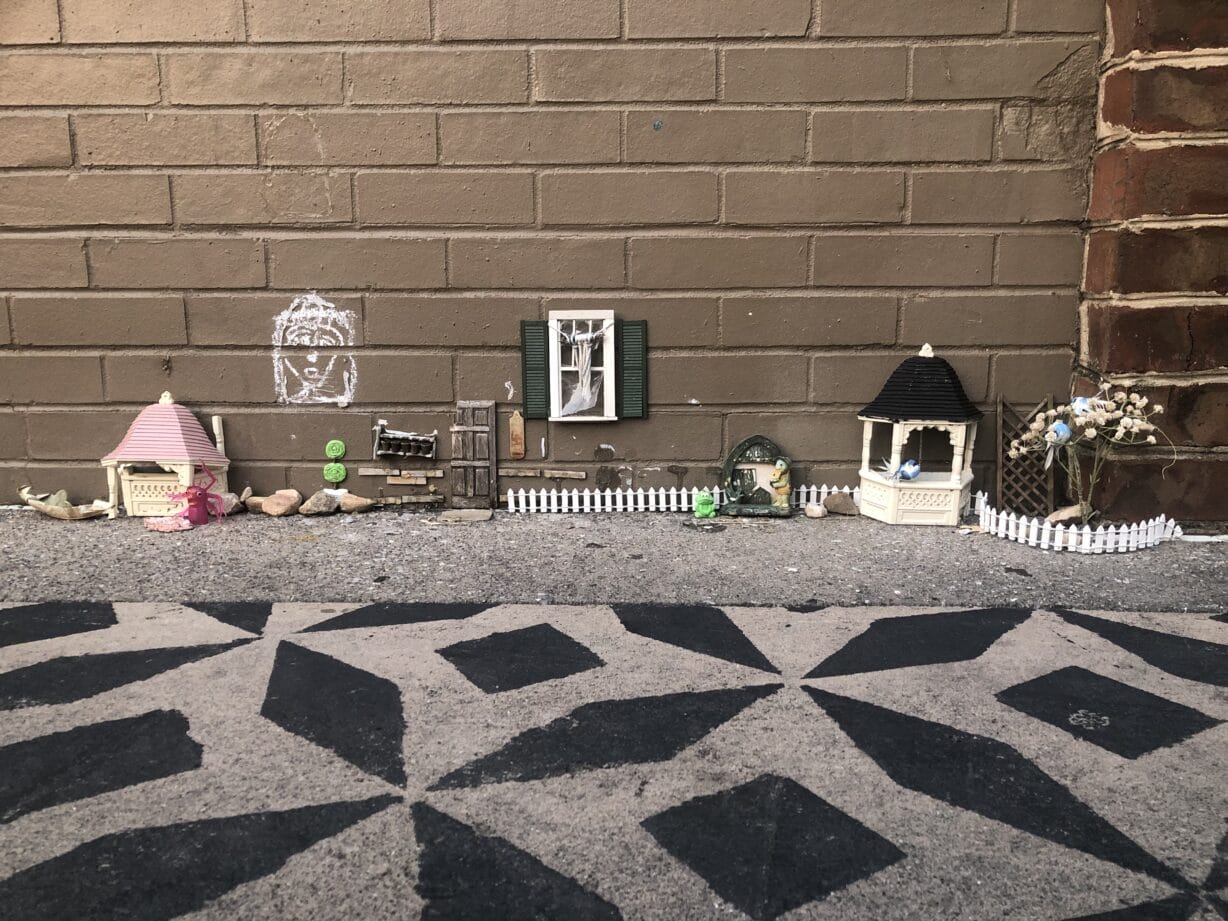
By Sofia Samatar
“The Friendly City” is a weekly column about walking in Harrisonburg that will run during 2024. Each week, your friendly correspondent, writer and teacher Sofia Samatar, will reflect on a walk in our city.
If you know the Friendly City, you are familiar with its smallest house, tucked into an alley against the wall of the Finnigan’s Cove restaurant. At the moment, the main features of this tiny domicile are a pair of gazebos (one crushed), a white picket fence, a front door, and a window with green shutters. I say “at the moment” because the smallest house has gone through a number of metamorphoses over the years. I have photographed it many times, like other passersby—those locals or students or traveling Civil War Trail enthusiasts you can find squatting in the alley, drawn to the city’s minutest, most inexplicable attraction. I can remember when the wooden door was whole and uncracked, the fence smaller and unpainted, the mat adorned with the word Welcome surrounded by a woven design. There used to be a doll-size snow shovel leaning against the wall. A letterbox. A crate with gardening tools and even tiny seed packets. In those days, however, there was no window, no chalk portrait on the brick, and no gazebo, not even a broken one. The smallest house goes through periods of growth and decline, of expansion and contraction, the systole and diastole of a heart.
If you asked me to point out the physical location of the city’s heart, I would place it here, not only because this alley cuts through the center of downtown, connecting the main parking garage with the courthouse, but because this is where you can take the collective pulse. The smallest house—humble, quirky, unprotected by official sanction or support, and exposed to passing feet in a busy walkway—offers an excellent measure of civic health. It’s a good sign, I think, that so many people walk through here every day, zip past on skateboards and scooters, or stand about smoking or checking their phones, and the smallest house continues to exist. This diminutive artwork, so vulnerable to theft, defacement, and destruction, could not survive in a city with a meaner spirit.
Sensitive to changes in the temper of the town, the smallest house is the first place to show symptoms of communal weakness and decay. Earlier this year, around graduation time, somebody kicked it to pieces, almost obliterating it and wrecking the pink gazebo. But lo and behold, as if attended by industrious elves, the smallest house regenerated almost overnight. It even extended along the wall. A new fence appeared, a miniature cherry tree, a trio of bluebirds, a toy turtle holding a plastic bouquet.
This suggests that the Friendly City is not without flaws—we can be malicious, careless, or just filled with an overwhelming energy that turns aggressive. But we can also gather a different kind of energy around a wounded spot. We can rebuild, and we can grow. I’m encouraged and uplifted every time I pass the smallest house, with its row of longsuffering plant pots, their green shoots torn away, its surprisingly hardy tree that seems to be made of some kind of playdough, its line of stones arranged into a wall.
I have heard that this fanciful public art installation is the work of a local musician and performer, but surely the point of public art is that it belongs to the public. The smallest house is in our hands, given over to the community more fully than any municipal sculpture, as it’s unauthorized, unfunded, and unsigned. It may have originated with one person, but others have contributed to its ongoing life. Personally, when I find a likely object on the street, I donate it to the house. I particularly recall a little plastic man I’d found in the gutter. Maybe you remember him—a sleek fellow in a gray suit, his arms crossed, his head turned to show off a profile adorned with a dashing mustache and lush black hair. He used to stand by the castle-like archway, where the toy turtle is now, near a plastic campfire where a cauldron presumably boiled his evening meal. A pale green dragonfly hung out with him for a while. Then the man and the bug both disappeared. A pair of aliens replaced them, one with a strange dark jewel in its abdomen. Then came the bright green, peg-like creatures in a flowered box labeled Goon Babies. Remember them?
Today I am adding a pair of new tenants: a tentacled gremlin of squishy pink plastic and a fuzzy green frog. The frog has a small metal loop on its head, as if it was once a child’s pendant. The pink monster is hollow, like a finger puppet or a playful pencil ornament. I position them here in the heart of the city, against the bricks of a venerable building on the square, only a block away from the town’s oldest extant structure, the mysterious Thomas Harrison House (mysterious because, according to archa eological evidence, the city’s founder never lived there). The little frog has a few whitish patches where its green down has rubbed off. Will it be okay in the rain? I leave it behind, relinquishing it to the elements, to the city, thinking that this is only right, as I found it on the street, reflecting that the child who lost it might rediscover it here, and wondering, too, what an outsider would think of this gesture, imagining a foreign anthropologist observing me from the corner, a stranger jotting down notes on the rituals of this place, recording how the inhabitants, as they traverse the alley, place small votive objects on the doorstep of the local shrine.












